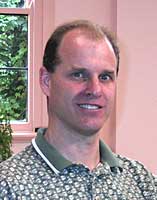
View Dr Barry Pogson's photo gallery
You can order the DVD from the Academy for $15 (including GST and postage)
Dr Barry Pogson was interviewed in 2001 for the Interviews with Australian scientists series. By viewing the interviews in this series, or reading the transcripts and extracts, your students can begin to appreciate Australia's contribution to the growth of scientific knowledge.
The following summary of Pogson's career sets the context for the extract chosen for these teachers notes. The extract covers his research into how carotenoids function in plants. Use the focus questions that accompany the extract to promote discussion among your students.
Barry Pogson was born in 1962 in Moss Vale, New South Wales. After finishing high school he worked as a bank clerk for 12 months before deciding to attend university. In 1986 he received a BSc from Macquarie University where he studied ecology and land management/geography. For his honours degree he moved to the University of New South Wales and investigated how seeds germinate and how they utilise food reserves in seeds.
Pogson worked jointly at Macquarie University and the CSIRO Division of Horticulture on his PhD research. His studies of how tomatoes ripen and soften, in particular how enzymes control these processes, led to his receiving a PhD in 1992.
From 1992-94 as a postdoctoral scientist on a joint project between the CSIRO Division of Horticulture and New Zealand, he worked to understand the process of senescence in broccoli and how it is controlled by ethylene.
Pogson then moved to the USA and from 1994-97 was a postdoctoral scientist with Dr Dean DellaPenna, first at the University of Arizona and then the University of Nevada. During this time he began his research into carotenoids and their function in photosynthesis.
From 1997-99 he was an Assistant Professor in the Department of Plant Biology at Arizona State University. While there he worked in the Photosynthesis Center and continued his work on the characterisation of plant pigments and their role in photosynthesis and chloroplast development.
In 1999 Pogson was appointed to a lectureship in the School of Biochemistry and Molecular Biology at the Australian National University and in 2001 became a senior lecturer there. He continues to investigate carotenoids in plants and how they function in plants, with an additional focus on how antioxidants affect plant development and the way plants respond to environmental stress.
He was awarded the Fenner Medal by the Australian Academy of Science in 2001 and the Goldacre Medal by the Australian Society for Plant Physiology in 2000. In 1995 he received the New Investigator Award from the Gordon Research Conference on Carotenoids.
What caused you to return from Phoenix to Australia?
Family reasons were strong. By that stage I had three children, and my wife and I were keen on letting them know who their grandparents were – that they lived not on an aeroplane but actually in a place not too far away from them. Academically, too, coming to the ANU was a great move. It’s a good place to be.
You currently have a lectureship at the ANU and are involved in research. What are you working on?
My project is still an extension of the work I started with Dean DellaPenna: how carotenoids function in plants. It is taking a broader view now, looking at how antioxidants as a whole affect both plant development and the way a plant can respond and survive under environmental stress – things like excess light, excess temperature, drought, all the sorts of things our farmers have to deal with routinely. Antioxidants act as safety valves for a lot of these processes, especially for photosynthesis, which is the key process for a plant. How much energy it makes is how fast it can grow. But if it doesn’t make the energy the right way, or if it is under too much light or extremes of temperature, then the photosynthesis process won’t function properly. And if it doesn’t function properly, the plant needs safety valves. These carotenoids and other molecules like vitamin C and vitamin E act as safety valves, giving a way to get rid of the excess energy and stop the formation of free radicals that damage the plant and impair growth.
Antioxidants play a similarly important role in our human diet. Carotenoids are linked to protection against certain cancers, for instance. The vitamin A role of carotenoids is critical for human health, absolutely essential. Another such process is macular degeneration of the eye. The same carotenoids that are involved in acting as a safety valve in plants are found in the centre part of our eye, the macula. Age-related blindness is the most common cause of blindness in the elderly, and that has been correlated with deficiencies in these two carotenoids. So animals – in particular, humans – have taken advantage of the same pigments as plants have adapted as safety valves, and it seems that we are using the safety valves too.
Select activities that are most appropriate for your lesson plan or add your own. You can also encourage students to identify key issues in the preceding extract and devise their own questions or topics for discussion.
© 2025 Australian Academy of Science